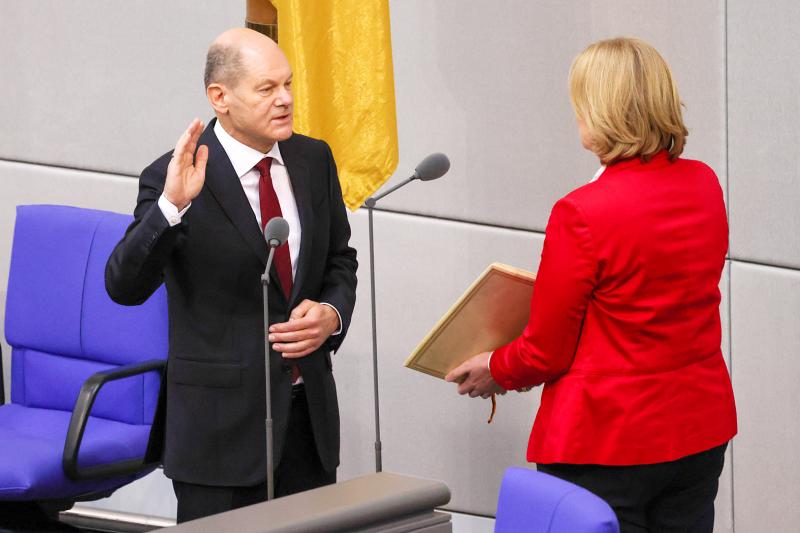German lawmakers elected Social Democrat Olaf Scholz as chancellor on Wednesday last week, ending 16 years of conservative rule under Angela Merkel. Merkel, 67, Germany’s first woman chancellor, retired from politics after four consecutive terms, is Germany’s first post-war leader to step aside of her own accord.
Merkel belongs to the center-right Christian Democratic Union of Germany (CDU), while the Social Democratic Party (SPD), to which Scholz belongs, is center-left in the political spectrum. In the past four years, Scholz served as vice chancellor and finance minister in coalition with Merkel.
Former mayor of Hamburg and Germany’s labor minister during the global financial crisis, Scholz, 63, who turned emulating Merkel in style and substance into a winning strategy, forged a “traffic light” coalition — a name deriving from the respective parties’ colors — with the pro-spending, environmentalist Greens and the fiscally more conservative, libertarian Free Democrats (FDP).

Photo: Reuters 照片:路透
This is Germany’s first national three-way ruling coalition, bringing together unlikely political bedfellows. The alliance aims to slash carbon emissions, overhaul decrepit digital infrastructure, modernize citizenship laws, lift the minimum wage and have Germany join a handful of countries worldwide in legalizing marijuana.
Scholz leads a 17-member Cabinet, with one more minister than Merkel’s. This is Germany’s first gender-balanced Cabinet, with women making up half the number (excluding the chancellor himself).
Annalena Baerbock, Greens co-leader and the new foreign minister, has promised to put human rights back at the center of German diplomacy, and pledged a tougher line with authoritarian states such as Russia and China after the business-driven pragmatism of the Merkel years.

Photo: Bloomberg 照片:彭博社
Scholz and his team promise stability just as France braces for a bitterly fought presidential election next year and Europe grapples with the enduring aftershocks of Brexit.
(Lin Lee-kai, Taipei Times)
德國議員上週三選出社會民主黨的奧拉夫‧蕭茲為總理,結束了安格拉‧梅克爾長達十六年的保守執政。六十七歲的梅克爾是德國首位女總理,在連續四屆任期結束後從政壇退休。她是德國戰後第一位主動辭職的領導人。
梅克爾屬於中間偏右的基督教民主黨(CDU),蕭茲所屬的社會民主黨(SPD),其政治光譜為中間偏左。在過去四年中,蕭茲為梅克爾政府之副總理兼財政部長。
現年六十三歲的蕭茲曾任漢堡市長,並曾在全球金融危機期間擔任德國勞工部長。蕭茲在風格及實質上對梅克爾的仿效,成為他勝選的戰略。社民黨的他與擁護支出、關心環保的綠黨,以及財政上較保守的、自由派的自由民主黨(FDP),組成了「紅綠燈」聯盟,以這三個政黨的顏色(紅、綠、黃)命名。
這是德國史上第一個三方執政聯盟,將過去不太可能是政治夥伴的三個政黨聯合在一起。該聯盟之政策目標為減少碳排放、翻新老舊的數位基礎設施、將公民法現代化、提高最低工資,以及合法化大麻,讓德國加入全球少數幾個大麻合法化國家之行列。
蕭茲領導的內閣有十七位成員,比梅克爾內閣多一位部長。這也是德國第一個性別平衡的內閣,除了總理蕭茲,內閣有一半的成員為女性。
新任的外交部長安娜萊娜‧貝爾伯克為綠黨聯合領導人,她承諾將人權重新置於德國外交的中心,對俄羅斯和中國等威權國家採取更強硬的立場,一反過去梅克爾時代以商業為導向的實用主義。
蕭茲及其團隊承諾維持穩定,在法國準備迎接明年激烈的總統大選,歐洲正努力克服英國脫歐後續的餘震之際。
(台北時報林俐凱)

The winner of next month’s US presidential election will govern a nation of more than 330 million people, but the contest will almost certainly be decided by just tens of thousands of voters — a tiny fraction of the populace — in a handful of states. That’s because only seven of the 50 states are truly competitive this year, with the rest all comfortably Democratic or Republican, according to public opinion polls. Among those seven battlegrounds, Pennsylvania, the most populous, stands out as the most likely state to determine whether Democrat Kamala Harris or Republican Donald Trump is the next president. The

In many places around the world, summer is a time of brutal heat and humidity. What’s more, global climate change is expected to make things worse. The world is experiencing an upward trend in temperatures, with 2023 standing out as the warmest year ever recorded. Even in temperate regions, extreme heat waves have become more frequent occurrences. Thus, it should come as no surprise that people are always looking for new ways to beat the heat. While the first action most people take is to turn on their air conditioning units as temperatures go up, other effective measures can be taken

Continued from yesterday(延續自昨日) https://www.taipeitimes.com/News/lang Just as people today have smart tips for staying cool, ancient civilizations also had their own methods to beat the heat. Ancient Romans, for example, came up with numerous ingenious ways to cool off. Clever city planning and architecture were used to deal with the high temperatures in ancient Rome. Fountains and parks were thoughtfully placed throughout the city to offer people relief. Furthermore, buildings were constructed with thick stone walls that did an excellent job of stabilizing internal temperatures. Narrow streets, lined with tall walls, also created plenty of shade for pedestrians. The ancient Roman

Imagine the thrill of diving into the ocean, holding your breath, and exploring underwater worlds without any modern gear. This is the life of the haenyeo, South Korea’s sea women. Armed with only diving goggles and handmade tools, these skilled divers venture into the ocean’s depths to manually harvest marine products like abalone and seaweed. The haenyeo tradition, dating back to the 17th century, was originally dominated by men. However, a combination of wars and deep-sea fishing accidents created a shortage of male labor. Women’s greater resistance to cold proved a blessing to the struggling communities. As a result, they began